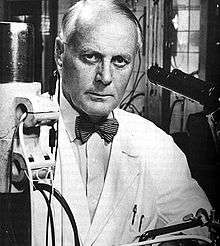Ragnar Granit
| Ragnar Granit | |
|---|---|
|
Ragnar Arthur Granit | |
| Born |
Ragnar Arthur Granit October 30, 1900 Riihimäki, Finland, Russian Empire |
| Died |
March 12, 1991 (aged 90) Stockholm, Sweden |
| Residence | Finland, Sweden |
| Citizenship |
Finnish (1900–1941) Swedish (1941–1991) |
| Fields | Physiology |
| Institutions | Karolinska Institutet |
| Alma mater | University of Helsinki |
| Notable awards |
|
Ragnar Arthur Granit ForMemRS[1] (October 30, 1900 – March 12, 1991) was a Swedish-speaking Finnish and later Swedish scientist who was awarded the Nobel Prize in Physiology or Medicine in 1967[2][3][4] along with Haldan Keffer Hartline[5] and George Wald "for their discoveries concerning the primary physiological and chemical visual processes in the eye".[6][7][8][9]
Education
Granit graduated in 1927 from the Faculty of Medicine of the University of Helsinki, Finland.
Career and research
When Finland became the target of a massive Soviet attack in 1940 during the Winter War (1939–1940), Granit sought refuge – and peaceful surroundings for his studies and research work – in the neighbouring capital of Sweden, Stockholm, at the age of 40.
In the next year, 1941, Granit also received Swedish citizenship, which made it possible for him to go on with his work and live without having to worry about the war, which lasted until 1945 in Finland. Granit remained a patriotic Finn throughout his life. After the Finnish-Russian Wars, Granit kept homes both in Finland and Sweden.
Granit was professor of neurophysiology at the Karolinska Institutet from 1946 to his retirement in 1967.[10][11]
Awards and honors
Granit was elected a Foreign Member of the Royal Society (ForMemRS) in 1960[1] and awarded the Nobel Prize in Physiology or Medicine in 1967.[9] Granit said that he was a "fifty-fifty" Finnish and Swedish Nobel laureate.[12]
References
- 1 2 3 Grillner, S. (1995). "Ragnar Granit. 30 October 1900-11 March 1991". Biographical Memoirs of Fellows of the Royal Society. 41 (0): 184–197. doi:10.1098/rsbm.1995.0012. ISSN 0080-4606.
- ↑ Raju, T. N. (1999). "The Nobel Chronicles". The Lancet. 354 (9178): 605–779. doi:10.1016/S0140-6736(05)77968-X. PMID 10470741.
- ↑ Shampo, M. A.; Kyle, R. A. (1998). "Ragnar Granit—Nobel Laureate in Medicine". Mayo Clinic proceedings. Mayo Clinic. 73 (11): 1082. doi:10.4065/73.11.1082. PMID 9818044.
- ↑ Dowling, J. E.; Ratliff, F. (1967). "Nobel Prize: Three Named for Medicine, Physiology Award". Science. 158 (3800): 468–473. doi:10.1126/science.158.3800.468. PMID 4860394.
- ↑ Granit, R.; Ratliff, F. (1985). "Haldan Keffer Hartline. 22 December 1903-18 March 1983". Biographical Memoirs of Fellows of the Royal Society. 31 (0): 262–292. doi:10.1098/rsbm.1985.0010. ISSN 0080-4606.
- ↑ Kernell, D. (2000). "Ragnar Granit 100 Years – Memories and Reflections". Journal of the History of the Neurosciences. 9 (3): 280–285. doi:10.1076/jhin.9.3.280.1791. PMID 11232369.
- ↑ Noguera Palau, J. J. (2000). "Ragnar Granit. Helsinki (1900–1991)". Archivos de la Sociedad Española de Oftalmología. 75 (4): 293–294. PMID 11151162.
- ↑ Bouman, H. D. (1968). "Ragnar Granit, M.D., Ph.D". American journal of physical medicine. 47 (1): 1. PMID 4868641.
- 1 2 "Ragnar Granit - Biographical". Nobel.se. 1991-03-12. Retrieved 2016-03-08.
- ↑ "Ragnar Granit Sההtiצ - Ragnar Granit Foundation". Rgs.fi. 2012-03-28. Retrieved 2016-03-08.
- ↑ "Ragnar Granit Institute". Rgi.fi. Retrieved 2016-03-08.
- ↑ Ragnar Granit in the National Biography of Finland: There have since been occasional arguments about how many of the observations that led to the Nobel Prize were made only after Granit arrived in Sweden and about whether he is 'a Finnish or a Swedish Nobel laureate'. Granit commented diplomatically on the matter by saying "fifty-fifty". When he received his Nobel Prize, Granit was indeed a Swede by citizenship; but a significant amount of his experimental work had been done in Oxford and Helsinki, and even in Stockholm his colleagues were still mostly Finns.

